The Internet Computer (ICP) protocol is making waves in the blockchain world with its recent integration of Threshold-Schnorr signatures.this move positions ICP as a potential “layer zero” for bitcoin, aiming to enhance functionality, security, and scalability for bitcoin-based applications.
But what exactly does this mean? Let’s break it down.
Bitcoin’s Limitations and DeFi’s Rise:
Bitcoin, the undisputed king of cryptocurrencies, has revolutionized digital finance.however, its core protocol faces limitations in terms of scalability and smart contract functionality.this restricts the development of sophisticated decentralized finance (DeFi) applications on the Bitcoin network itself.
Enter DeFi protocols like those built on the Internet computer. these platforms offer developers a more flexible environment to create complex financial applications. however, interacting with bitcoin from these external blockchains has historically been cumbersome and inefficient.
Threshold-Schnorr Signatures: The Key to Integration
Threshold-Schnorr signatures are a cryptographic innovation that allows for a more secure and efficient way for multiple parties to sign transactions on a blockchain. in the context of ICP and Bitcoin, this integration enables ICP smart contracts to interact directly with the bitcoin network.
Here’s how it unlocks new possibilities:
- Rune Integration: ICP can now seamlessly integrate with runes, the new bitcoin token standard expected to launch with the upcoming Bitcoin halving. this opens doors for DeFi applications built on ICP to leverage Bitcoin’s security and network effects.
- Ordinal Inscription: ICP smart contracts can interact with ordinals, a recent development that allows users to inscribe data onto individual Satoshis (the smallest unit of bitcoin).this opens up possibilities for innovative non-fungible token (NFT) use cases on the Bitcoin network.
- Enhanced DeFi Interoperability: The ability to interact with ERC-20 tokens, a popular standard on the Ethereum blockchain, becomes possible. This fosters a more interconnected DeFi ecosystem where assets can flow freely between different blockchains.
- Streamlined Taproot Transactions: ICP can facilitate Taproot transactions, a powerful bitcoin upgrade that enhances privacy and scalability.this paves the way for more complex and efficient DeFi applications built on Bitcoin.
ICP as “Layer Zero”: A Bold Vision
Dfinity, the company behind the Internet computer, envisions ICP as a “layer zero” for bitcoin. this signifies a foundational layer that provides essential functionalities for applications built on top of bitcoin. By enabling secure and efficient interaction with Bitcoin, ICP aims to become the go-to platform for developers building next-generation DeFi applications that leverage Bitcoin’s security and reach.
Looking Ahead: A Collaborative Future
The Internet Computer’s Threshold-Schnorr integration marks a significant step towards a more interoperable and scalable blockchain ecosystem. While the full implementation is expected by summer 2024, this development has already sparked excitement within the developer community.
Whether ICP will truly become the “Bitcoin Layer Zero” remains to be seen. however, one thing is certain: innovations like threshold-Schnorr signatures are paving the way for a future where different blockchains work together seamlessly, ultimately benefiting users and furthering the potential of DeFi.





